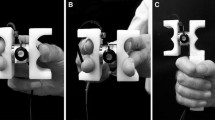Abstract
When subjects repetitively lift an object, the grip force they select is influenced by the mechanical object properties of the preceding lift. Similar effects on grip force scaling are observed whether the subsequent lift is performed with the same hand or the hand contralateral to the preceding lift. Here we demonstrate that passive vibration of the hand muscles involved in the generation of grip force in the interval between two blocks of lifting trials interferes with predictive grip force scaling. Following ten trials in which subjects lifted an object with constant mechanical properties with the dominant hand, muscle vibration was given to the first interosseus and adductor pollicis muscles of the dominant hand during a 10-min rest period. Compared with the last lift preceding vibration, peak rates of grip force increase and peak grip forces were scaled too high during the first lift following vibration whether the lift was made with the dominant or non-dominant hand. Subjects scaled grip force accurately to the object properties within three lifts following vibration. If subjects rested for 10 min after the first ten trials and received no vibration, then there was no significant difference in the peak grip force or its rate of increase between the last lift preceding rest and the first lift following it. We suggest that vibration impairs the memory processes responsible for predictive grip force scaling. Our data are consistent with the recent suggestion that these memory processes are neither specific for a certain motor action nor do they reflect internal representations of mechanical object properties.



Similar content being viewed by others
References
Cadoret G, Smith AM (1996) Friction, not texture, dictates grip forces used during object manipulation. J Neurophysiol 75:1963–1969
Cole KJ, Rotella DL (2002) Old age impairs the use of arbitrary cues for predictive control of fingertip forces during grasp. Exp Brain Res 143:35–41
Flanagan JR, Johansson RS (2002) Hand movements. In: Ramshandran VS (ed) Encyclopedia of the human brain, vol 2. Academic Press, San Diego, pp 399–414
Gordon AM (1991) Visual size cues in the programming of manipulative forces during precision grip. Exp Brain Res 83:477–482
Gordon A, Westling G, Cole K, Johansson R (1993) Memory representation underlying motor commands used during manipulation of common and novel objects. J Neurophysiol 69:1789–1796
Gordon A, Forssberg H, Iwasaki N (1994) Formation and lateralization of internal representations underlying motor commands during precision grip. Neuropsychologia 32:555–568
Jenmalm P, Johansson RS (1997) Visual and somatosensory information about object shape control manipulative fingertip forces. J Neurosci 17:4486–4499
Johansson RS (1996) Sensory control of dexterous manipulation in humans. In: Wing AM, Haggard P, Flanagan JR (eds) Hand and brain. Academic Press, San Diego, CA, pp 381–414
Johansson RS, Westling G (1988) Coordinated isometric muscle commands adequately and erroneously programmed for the weight during lifting task with precision grip. Exp Brain Res 71:59–71
Marsden CD, Meadows JC, Hodgson HJF (1969) Observations on the reflex response to muscle vibration in man and its voluntary control. Brain 92:829–846
Monzée J, Lamarre Y, Smith A (2003) The effects of digital anesthesia on force control using precision grip. J Neurophysiol 89:672–683
Naito E, Ehrsson HH, Geyer S, Zilles K, Roland PE (1999) Illusory arm movements activate cortical motor areas: a positron emission tomography study. J Neurosci 19:6134–6144
Naito E, Roland PE, Ehrsson HH (2002) I feel my hand moving: a new role of the primary motor cortex in somatic perception of limb movement. Neuron 36:979–988
Nowak DA, Hermsdörfer J, Glasauer S, Philipp J, Meyer L, Mai N (2001) The effects of digital anaesthesia on predictive grip force adjustments during vertical movements of a grasped object. Eur J Neurosci 14:756–762
Nowak DA, Glasauer S, Hermsdörfer J (2003) Grip force efficiency in long-term deprivation of somatosensory feedback: observations in a deafferented woman. Neuroreport 14 (in press)
Quaney B, Cole K (2002) Memory for grip force is not based upon the object properties. Soc Neurosci Abstr 28:6654
Quaney BM, Rotella DL, Peterson C, Cole KJ (2003) Sensorimotor memory for fingertip forces: evidence for a task-independent motor memory. J Neurosci 23:1981–1986
Salimi I, Hollender I, Frazier W, Gordon AM (2000) Specificity of internal representations underlying grasping. J Neurophysiol 84:2390–2397
Sinnaeve A, Dubrowski A, Carnahan H (2002) Evidence for the use of both iconic and long-term memory systems for friction when grasping. Soc Neurosci Abstr 28:2684
Witney AG, Goodbody S, Wolpert DM (2000) Learning and decay of prediction in object manipulation. J Neurophysiol 84:334–343
Wolpert DM, Flanagan JR (2001) Motor prediction. Curr Biol 11:R729–R732
Wolpert DM, Ghahramani Z, Jordan MI (1995) An internal model for sensorimotor integration. Science 296:1880–1882
Acknowledgement
Dennis A. Nowak received a grant from the Deutsche Gesellschaft für Klinische Neurophysiologie (DGKN).
Author information
Authors and Affiliations
Corresponding author
Rights and permissions
About this article
Cite this article
Nowak, D.A., Rosenkranz, K., Hermsdörfer, J. et al. Memory for fingertip forces: passive hand muscle vibration interferes with predictive grip force scaling. Exp Brain Res 156, 444–450 (2004). https://doi.org/10.1007/s00221-003-1801-1
Received:
Accepted:
Published:
Issue Date:
DOI: https://doi.org/10.1007/s00221-003-1801-1




